To Stop Whale Strikes, Ships Were Asked To Slow Down. It Worked
12:17 minutes
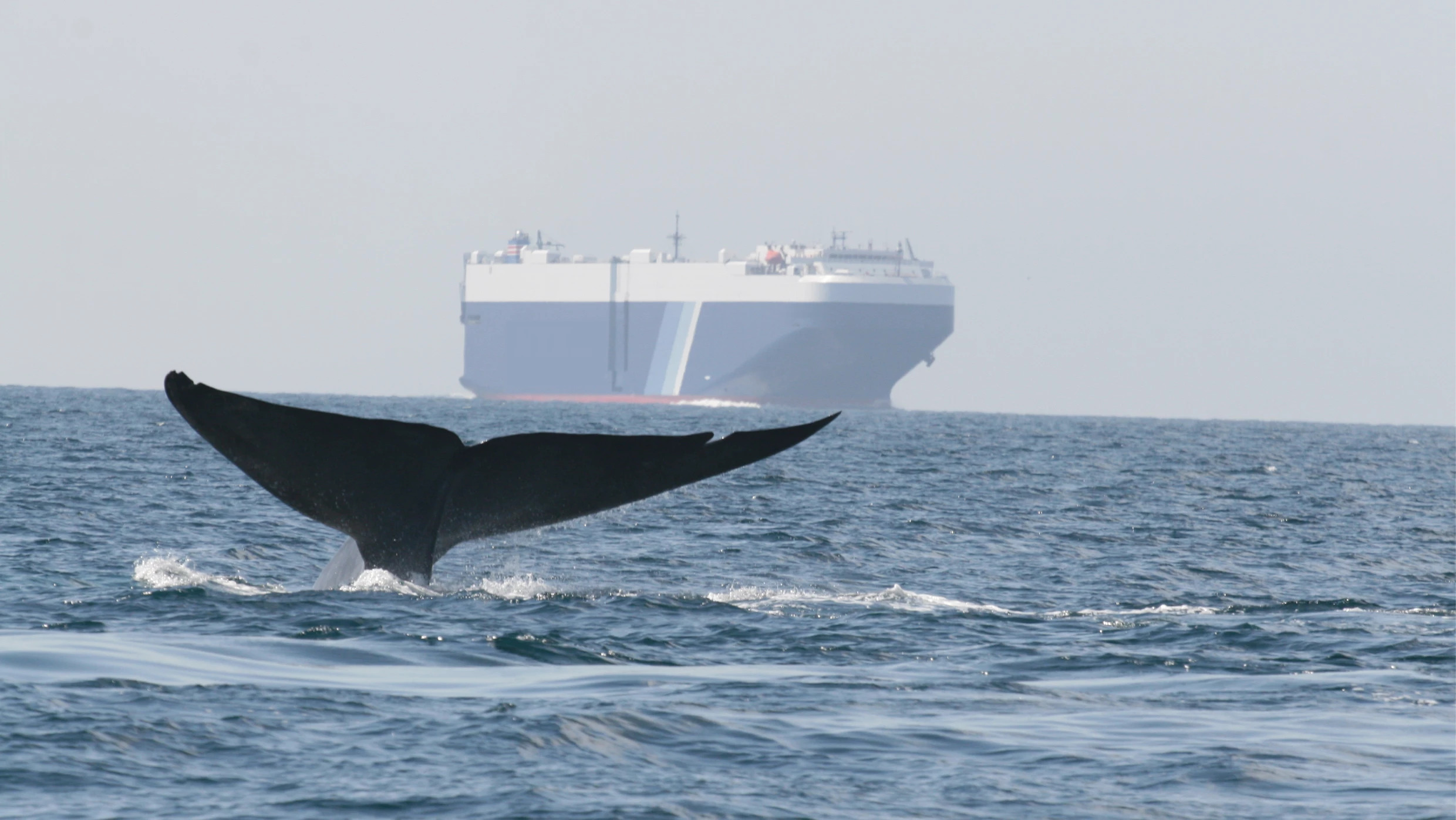
This article is part of The State of Science, a series featuring science stories from public radio stations across the United States. This story, by Michelle Loxton, was originally published by KCLU.
The Santa Barbara Channel is like an underwater national park with marine mammals, seabirds, fish and even shipwrecks.
Ocean currents from the north and south meet and mix here to create an ideal feeding grounds for marine life.
“Just the other day I was flying over the channel and we counted over 40 humpback whales in a rather small region feeding on fish,” said Sean Hastings, the Policy Management and Information Officer for the Channel Islands Marine Sanctuary—part of the National Oceanic and Atmospheric Administration or NOAA.
We met at the Santa Barbara Maritime Museum, close to his office, and sat in the museum’s library which is filled with books that are different shades of blues and greens—the colors you’d expect books about the ocean to be.
Hastings continues his story about a recent flight over the channel spotting all those whales.
“That’s quite a lot of blubber out there. And with that, you need a rich ocean environment to sustain those animals. And we’re very lucky that they come to our region in the summer months to feed,” said Hastings.
And it’s not just humpback whales that visit the channel, there are also gray whales and the world’s largest animal—blue whales, which are endangered and still recovering.
John Calambokidis has also spent a lot of time studying whales in and around the Santa Barbara Channel. He’s based in Olympia, Washington.
“We still have one of the most largest and thriving blue whale populations anywhere in the world here on our coast and off California,” said Calambokidis.
As founder and senior research biologist with Cascadia Research Collective, he’s studied large whales on the west coast and the human impacts on them for 40 years—including ship strikes.
Calambokidis points out that the whales have only recently had to deal with this threat.
“But it makes perfect sense why being the largest animal that’s ever lived and not really facing a threat like this, that they would not have evolved you know, a behavioral response to recognize this as a threat,” said Calambokidis.
Remember whales were here long before ships.
He says they’ve found blue whales, in particular, practice very little avoidance of ships.
“In most situations where whales are feeding deep, they actually may be even more distracted and less likely to respond to a close approach of a ship or less able to respond,” said Calambokidis. “And then the other thing you add to that is there’s very little opportunity for whales to be hit by ships and learn to avoid it because most ship strikes are fatal. So you’ve also kind of robbed of that capability to learn.”
Calambokidis says from the perspective of the ships, the vessels are so huge they sometimes don’t even know they’ve hit a whale.
“Even where they hit a whale and had it wrapped around the bow, they’ve sometimes been unaware of that until someone notices when they come into the harbor,” said Calambokidis.
“If you can imagine, these ships on average are about 800 to 1000 feet long and the ship driver is in the back of the ship, ten stories off the ocean. And there’s really no way they can see animals directly in front of them. You know, unfortunately, this is a situation similar to roadkill where no one wants to hit an animal,” said Sean Hastings from NOAA.
Because of the advancements within the shipping industry Hastings says these fatal whale strikes are really a relatively new problem.
“We were not aware of this issue 20 years ago. Ships and whales have shared the ocean for hundreds of years and only in the advent of faster ships, larger ships and more ships have we really seen a spike. In fatal ship strikes on these protected species,” said Hastings.
The actual number of fatal whale strikes that happen along our coast is really hard to track.
Yes, some whales wash ashore, NOAA found between one and three a year, but they think that’s just the tip of the iceberg.
“And the reason we don’t find them or see them is because the ocean’s a large place. These animals are, by nature, negatively buoyant, so when they die, they usually sink out of sight, out of mind,” said Hastings.
They did some modeling and believe the number of whales killed by ships was 10 times more than the deceased whales actually found.
So they had a challenge on their hands. The whales are coming to the channel to feed or migrate through. And it’s not like you can get rid of the ships. There’s the large naval presence in the region and where the whales are congregating happens to be right next to three very important ports—Long Beach, Los Angeles and Hueneme.
“These ports account for over 40% of all imports to the United States. So a really high volume of commerce. And while we’re trying to protect these natural resources, we also want to maintain vibrant maritime commerce, because it really is the lifeblood of not only the U.S. economy, but the global economy,” said Hastings.
So for years NOAA and their partners tried to come up with solutions for these whale strikes and after not really having much success, about a decade ago, they had an idea—they called it the Protecting Blue Whales and Blue Skies incentive program.
A voluntary program that asks shipping companies to slow down to 10 knots in the channel, that’s about 12 miles an hour, between the months of May and November—when the whales are most present in the channel.
Essentially making the channel like a school zone.
In exchange for their participation, the shipping companies are rewarded with money—mostly state and federal grant funds—and recognition—you know, a big positive PR campaign.
18 global shipping lines signed up representing 90% of the container traffic coming over from Asia.
And the results? In 2021, NOAA says all the slowing down meant a 50% reduction in whale strikes.
And for the companies—incentives ranged from $5,000 to $50,000 per company depending on how much they slowed down.
Sean Hastings and I meander through the maritime museum with all its whale-themed exhibits and then take an elevator ride up to the very top of the building.
We walk out onto a balcony overlooking the harbor.
“It’s visually motivating. And to have the privilege to work on the ocean and for the ocean has been my life’s career and passion and dream. And it all comes together in this crow’s nest at the Santa Barbara Harbor,” said Hastings.
From our perch we look towards the ocean. Hastings tells me the best way to see this program in action is from above—but an even higher bird’s eye view than this.
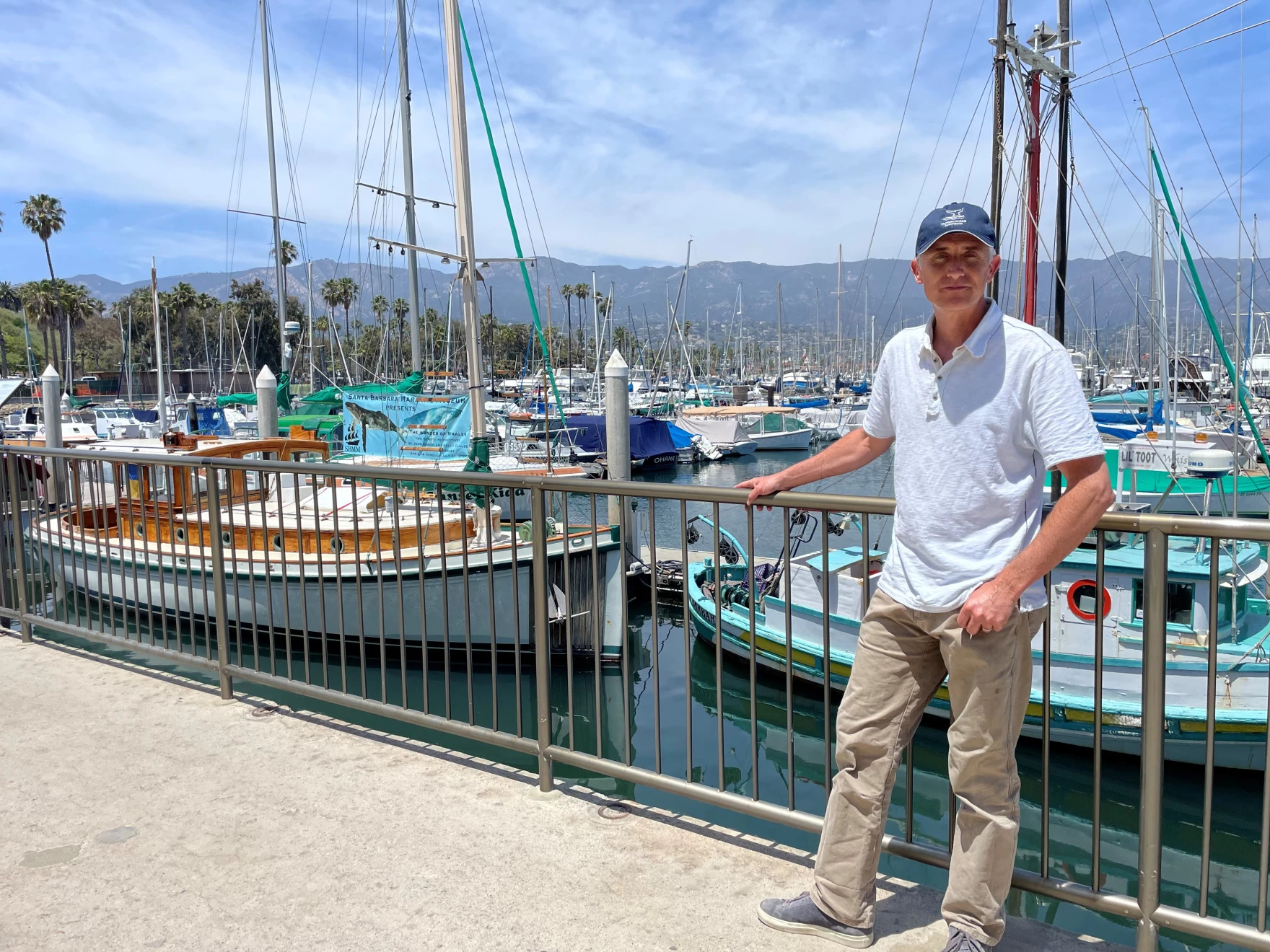
At Oxnard airport Sean Hastings, myself, along with other whale watching experts squeeze into a six-seater plane, ready for takeoff on a whale counting mission.
In no time we’re up in the air heading out over the Santa Barbara Channel.
We make our way to the south end of the shipping lanes—ships follow these strict lanes through the channel, like highways, coming to and from the ports. Our plan is to follow the shipping lanes northbound all the way up to Point Conception, close to Santa Barbara.
We’ll be checking the speeds of the ships—are they slowing down? And counting whales—I’m told to look out for a spout of water.
The plane we’re in has these special bubble-shaped windows—they’re made for survey operations—so whale counters can literally peer down, look left and right, and have a better view of the ocean below.
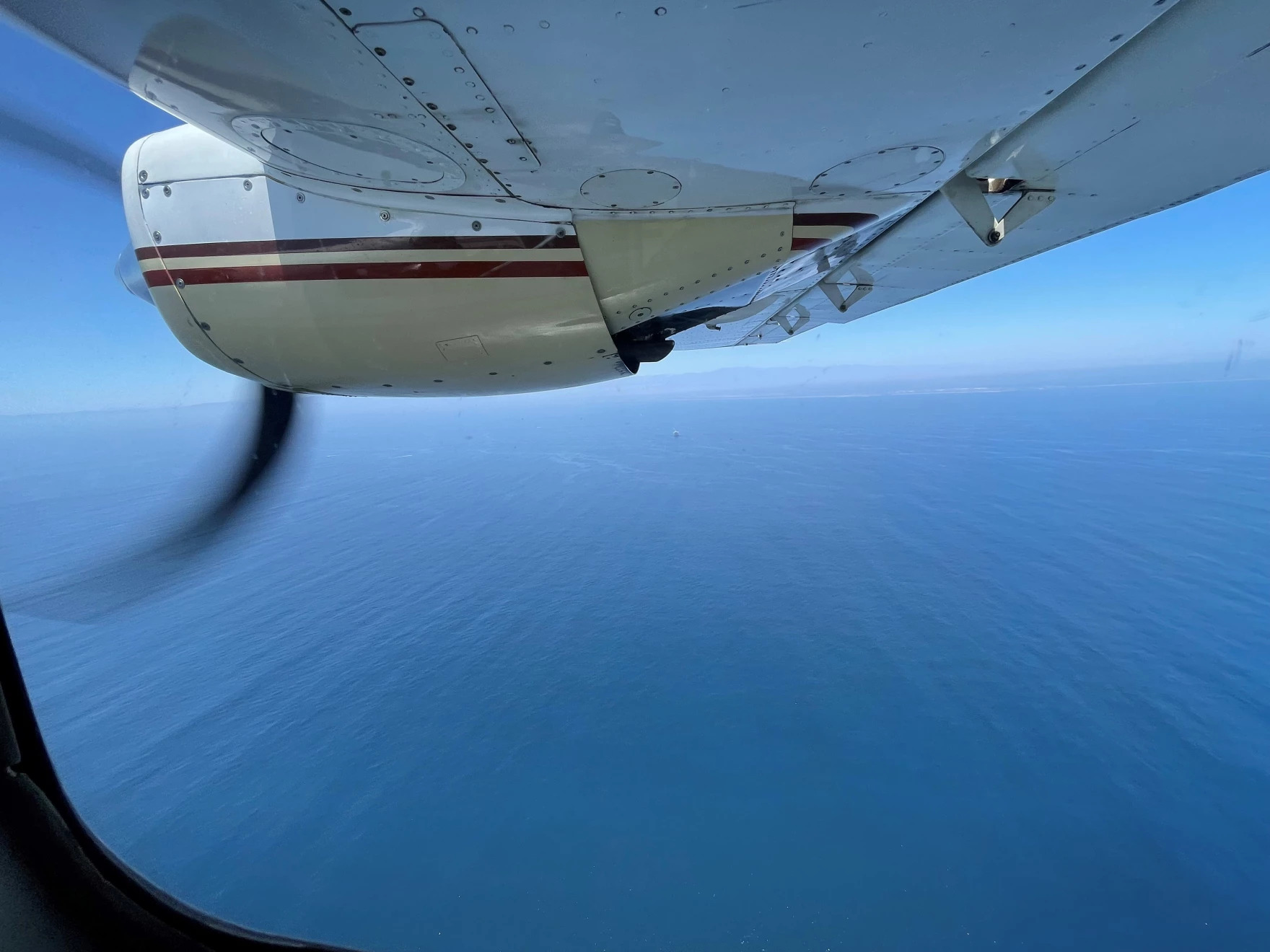
I thought the channel would have a lot of ships in it—I knew thousands of them transit through every year. But the reality is there are only between one and three ships in the channel at any one time. They’re allocated specific time slots at the port and are only allowed to enter the channel when it’s their turn.

Most of the container ships are traveling slowly, but there is one speeding through the channel looking almost like it may overtake the ship ahead of it—a good reminder that this is a voluntary program.
By the time we reach the northern part of the shipping lanes we haven’t spotted any whales yet. So we set a course for the Channel Islands.
We head past Santa Rosa and then San Miguel Island and spot sea lions resting on the beach. There are lots of dolphins and even a sunfish to spot… but no whales yet.
Then, close to one of the islands the team spots what looks like two speed boats racing along, with a straight line of white water behind them. It’s not boats but rather two gray whales migrating side by side. I would have missed them if it wasn’t for the whale spotters.
We spotted more ships than whales that day. Back at the airport my fellow whale watchers say it was unusually quiet. On some trips up to 30 whales have been spotted.
New rules are coming into effect next year that NOAA hopes will decrease whale strikes even more. The new rules will one—extend the current queueing area 13 nautical miles further away from the coast. And two—widen the ‘area to be avoided’ around the Channel Islands.
Sean Hastings explains how this helps.
“To get them over deeper water over the continental shelf where the animals are congregating. So as the ships come in from around the world, they’re fanning in and queuing up into the shipping lane. We want that to occur deeper, farther out to sea,” said Hastings.
This will essentially keep ships in the line up away from important breeding areas.
The ships we saw in the channel were all heading to one of three ports. And it is at those ports where the ‘Blue Skies’ part of this incentive program comes in.
“So right now we are on our south terminal. We are standing adjacent to a refrigerated cargo vessel that has containers of bananas on board,” said Giles Pettifor, the environmental manager for the Port of Hueneme in Oxnard.
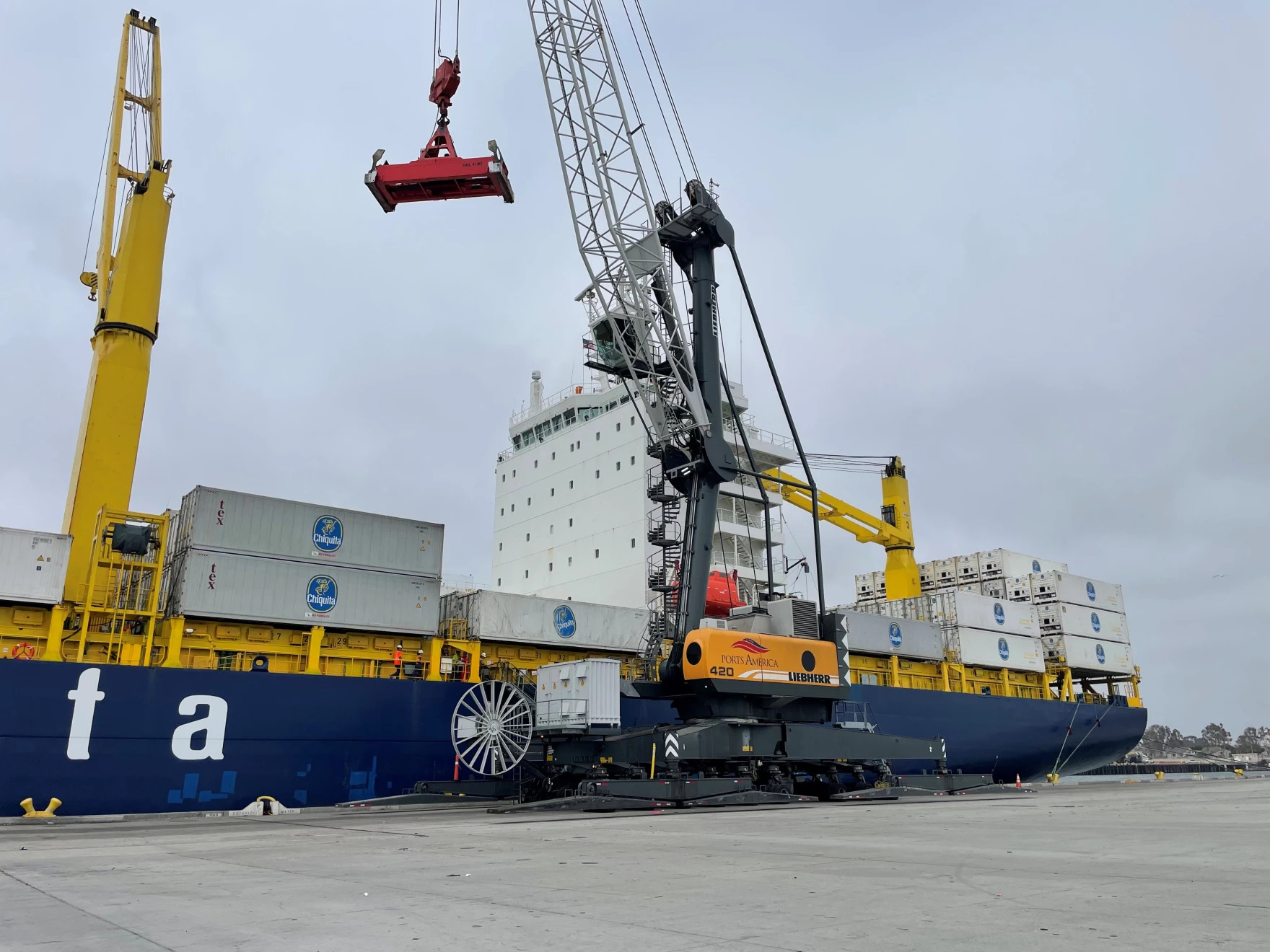
Across the wharf, new cars are being offloaded, on their way to dealerships.
These ships, to me, are huge but actually the Port of Hueneme handles smaller and fewer ships than L.A. and Long Beach because of their wharf’s constrained size and length.
Open 24 hours a day, Hueneme gets between five to seven vessels a week. In comparison the other southern California ports receive 50 to 60 vessels a day.
“Those [L.A. bound ships] are typically ships that are two to three times larger than this ship and can carry as many as 20 times the number of containers as this vessel we see in front of us right here,” said Pettifor.
Pettifor is responsible for getting the port in compliance with the clean air requirements and deadlines laid out by the California Air Resources Board.
“To get to that point of decarbonization and zero emission operation here and getting to those deadlines as quickly as we can,” said Pettifor.
One of their initiatives is onshore power which means the ships plug into electrical power while docked at the port, rather than burning fossil fuels and creating poor air quality.
“We’ve talked to folks in the community here that have lived next to the port for decades, and they would talk about back in the day before our shore power system, which allowed those ships to plug in and shut off those diesel engines. They would say come out of their apartment in the morning and they would have to hose off their patio furniture or they would have to wipe off the windshield of their car in the mornings because of that accumulation of soot particles from the ambient air around the port and how now that no longer is the case,” said Pettifor.
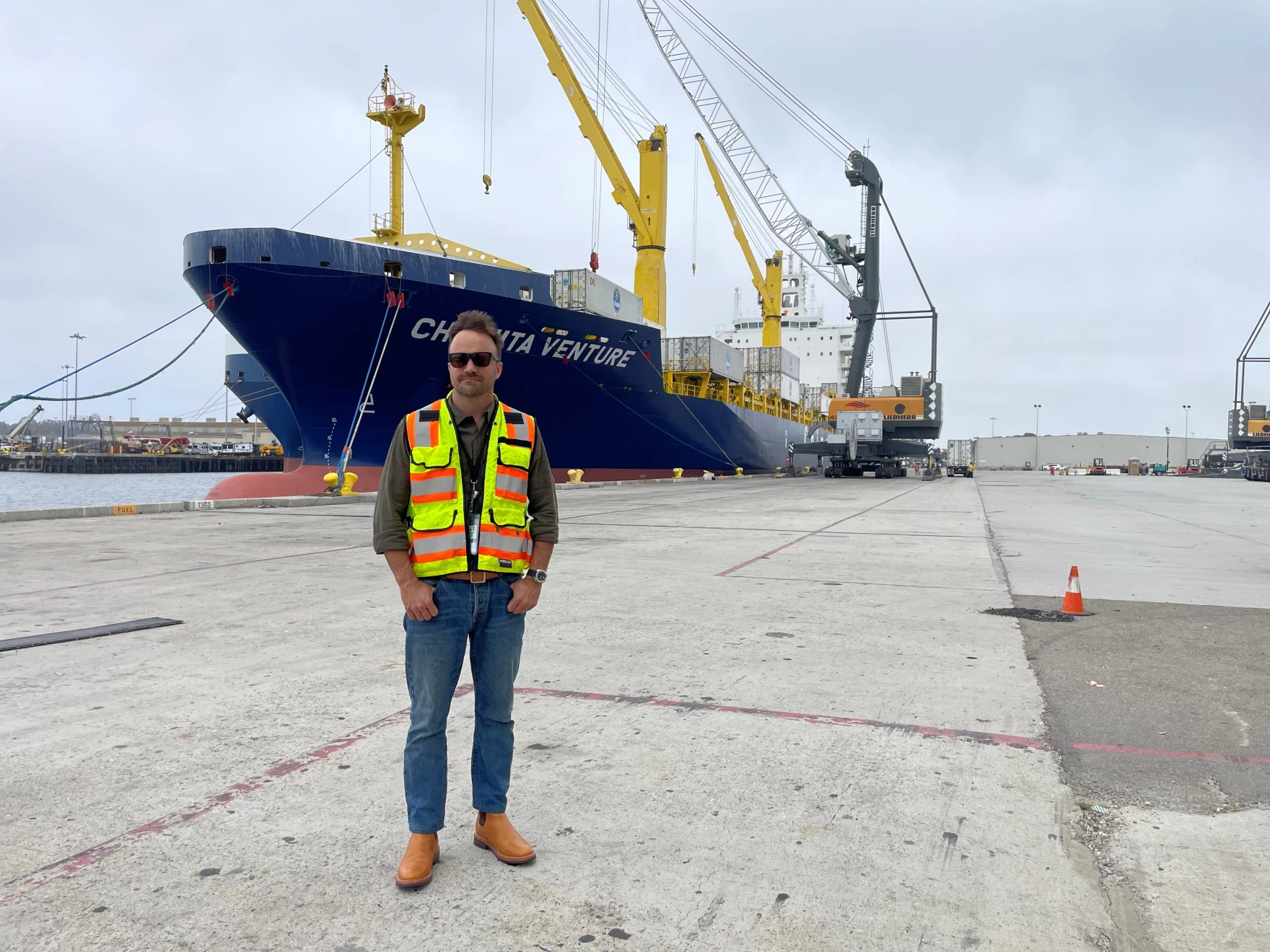
Currently onshore power is available for refrigerated container ships only. In 2025 container ships carrying vehicles will be able to hook up to onshore power. Hueneme says they’ll be one of the first ports globally to implement this.
So onshore power is one way to start cleaning up the air. But when ships slow down they burn less fuel and it means less air pollution—and that counts whether they’re traveling through the channel or docked at a port.
Ships are a big factor when it comes to emissions and poor air quality. They contribute more emissions of nitrogen oxide than any other single source in Ventura County.
“Ocean going vessels, they contribute about 40% of the total NOx emission in Ventura County,” said Ali Ghasemi, the Air Pollution Control Officer for the Ventura County Air Pollution Control District. He was also at the port that day.
He explained that NOx stands for nitrogen oxides, a principal component of smog.
With federal standards for clean air in place since the 1970s, Ventura County has made huge strides in cleaning up its air. Ghasemi explains exceedent days—when the county has gone over the standard, have decreased tremendously.
“In 1988 we had about 173 exceedant days. But in 2021 we have about nine days that we went above that standard,” said Ghasemi
But the Air Pollution Control District can’t regulate marine shipping so they’ve partnered with theProtecting Blue Whales and Blue Skiesincentive program.
They estimate since the program’s inception thousands of tons of smog-causing-emissions and tens of thousands of greenhouse gas emissions have been avoided—these affect human health and the health of the planet.
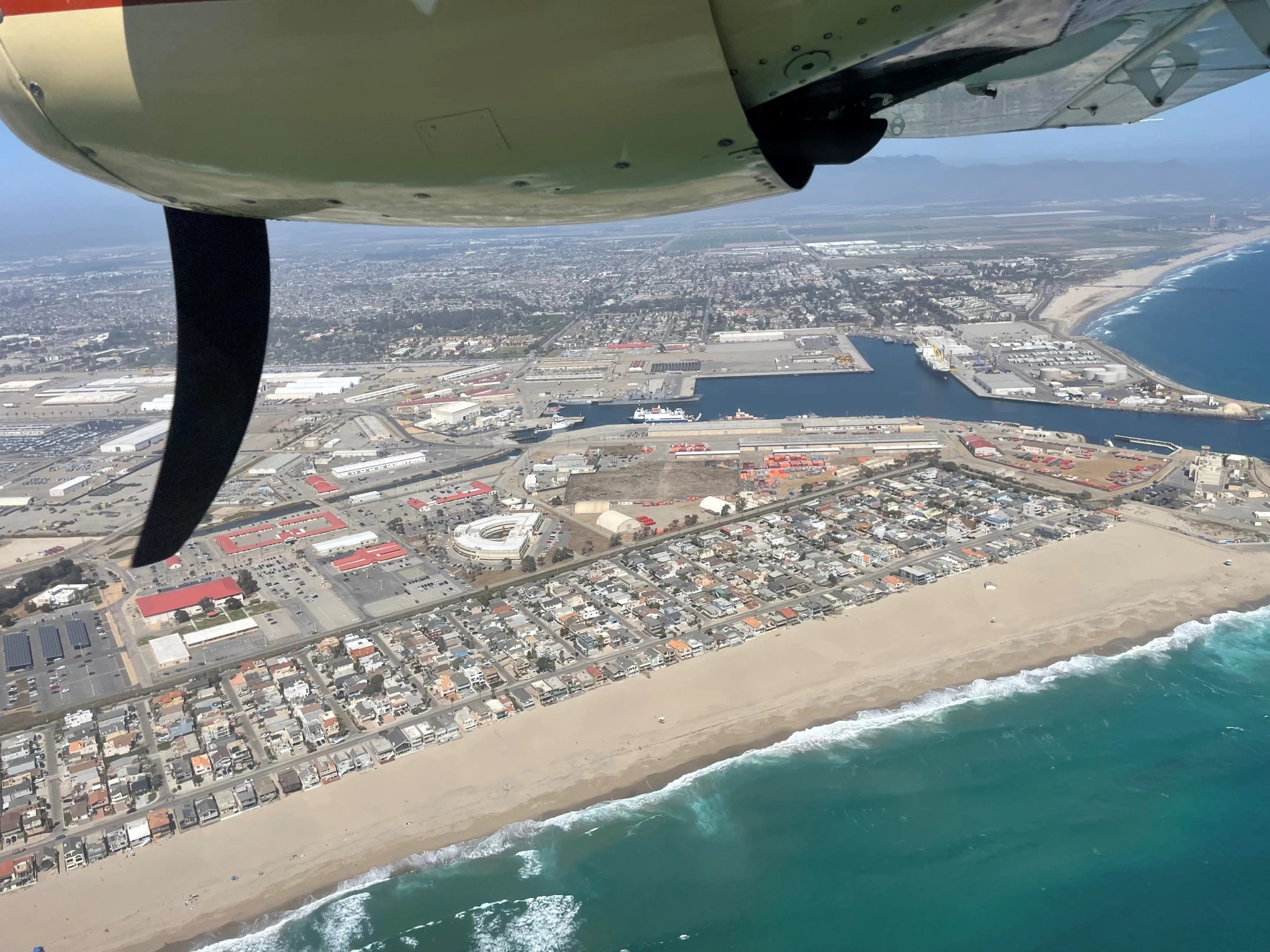
But remember this is an incentive program. They have to find funding to reward the shipping companies. And as more and more companies come onboard, and they want this, they’re going to need more money.
“Our program has been only funded up to the end of this year. Starting 2023 we haven’t we don’t have any incentive fund. We have applied through the state to get funding, but I’m not sure if we’re going to get it,” said Ghasemi.
This does put the future of the program in jeopardy.
Without fail, everyone I spoke to for this story said the recognition or positive PR part of this initiative has been really important to participating shipping companies. And here’s the interesting part.
Molly Pearson was the Planning Division Manager at the Air Pollution Control District for Santa Barbara County before retiring—the county is also part of this incentive program.
“And we’re seeing that they really appreciate that type of recognition as opposed to a monetary award,” said Pearson. “A lot of them will give them a monetary award and they’ll donate that money back to the program. We’ve seen that happening more and more each year.”
Meaning they probably don’t always do it for the money?
“The last two years we’ve asked them not to send it to us, but to keep it within the program, to do further research and to be able to expand the program,” said Lee Kindberg, the head of environment and sustainability at Maersk, North America—one of the largest shipping companies in the world.
Also part of the incentive program is Hapag-Lloyd. Another massive global shipping company. They chose a different approach with their incentive money.
“Certainly it would have been a wise move to return the money,” said Wolfram Guntermann, Hapag-Lloyd’s director of regulatory affairs. “However, our seafarers were extremely strained by the pandemic. They had to stay on board much longer than expected. They had no shore leave, but there were an entities in the ports, the seafarers mission.”
Hapag-Llyod donated their incentive money to the Seafarers Mission who visited their ships and provided things mariners would normally get during shore leave.
So does slowing down a massive ship affect the shipping companies’ bottom line? Well firstly slowing is now part of the voyage plan for these companies—you know part of the GPS instructions for captains. Also slowing down is more fuel efficient—fuel is the biggest cost for shipping companies.
And besides these companies have their own environmental goals.
Maersk has made a commitment of zero emissions by 2040. Hapag-Lloyd’s has set a target of zero emissions by 2045.
Plus there’s pressure from their customers.
“Many, many of our customers have come on board and are actually asking ‘what are we achieving together to reach a cleaner transport environment?’ And that’s absolutely marvelous.” said Guntermann from Hapag-Lloyd.
“About two thirds of our top 200 customers have set zero carbon goals. So delivering to them an environmentally safe product, something that is low carbon… where they have actually the data to show that they’re doing the right thing is very important to companies like the Amazons, the Nike’s,” said Kindberg from Maersk.
So you might be thinking, if it’s so important to slow down ships—you know for the whales, the air quality, climate change and for the shipping companies’ bottom line—why not make it compulsory?
Ahhh regulations!
Remember the whale biologist John Calambokidis from earlier in the article? He says some great things have come from theProtecting Blue Whales and Blue Skiesprogram but…
“But I’ve also been really frustrated that we haven’t done more to reduce ship strikes of blue whales. And I’m actually an advocate that, you know, instead of paying ships to slow down, we should just make them slow down,” said Calambokidis.
He would be even happier if shipping lanes were moved to the other side of the Channel Islands forcing ships to detour away from the Santa Barbara Channel.
Maersk and Hapag-Lloyd are slowing down up to 85% of the time. They say they’re doing it when it’s safe and feasible—remember they have schedules to meet.
What do the shipping companies say to regulations?
“If you’re going to have a regulation, enforce it. So that you have a level playing field and are not disadvantaging those companies that are trying to do the right thing by not enforcing. So the enforcement to us is a high priority,” said Lee Kindberg from Maersk.
Similarly Hapag-Lloyd said mandatory slowdowns should be decided and implemented by all stakeholders in order to maintain a level playing field.
NOAA’s Sean Hastings hopes voluntary compliance will bring the slow-down cooperation rate from what it is now—about 60 percent — up.
“Where we hope to go with this is, of course, increased cooperation to try and get it at 80 or 90 plus percent of all the ship transits off California to slow down. Where we fall short and what may be necessary in the future is mandatory vessel speed regulation,” said Hastings.
Regulations on the West Coast have been considered before at the state and federal level—they even exist on the east coast—but they just haven’t happened here, yet. Why? NOAA tells me that, because overall whale populations are recovering, individual fatal whale strikes seem to be less concerning to regulators right now. The priority has been put on the whole whale population.
On the air quality side, the California Air Resources Board told me that Ventura County, for example, is on track to meet federal Clean Air Act goals by 2026. Adding that they have an aggressive rulemaking schedule for the next five years, and that will provide even more emission reductions statewide. But, as for slowing down ships? It seems incentives rather than regulations continue to be the preference.
So this small program is having an outsized impact. But what many do believe might really tip the scales and make shipping more and more sustainable is you—the consumer.
“And as much as we all care about sustainable products, we also need to be thinking about how those products are moved around the world,” said Sean Hastings.
For example, when you buy something, do you think about how it gets to you? Is your latest purchase being transported on that ship I saw speeding through the Santa Barbara Channel that isn’t looking for whales or caring about the air quality? Or is it on a ship that’s part of theProtecting Blue Whales and Blue Skiesprogram?
It’s actually becoming possible to find this out.
Earlier this year the people behind the incentive program launched a new brand ambassador initiative where brands, who are interested in making their supply chain greener, receive data on if their shipping companies are slowing down—they also get data on air pollution and ship strikes on whales.
The idea is this information can then be passed onto consumers.
And a few companies have already joined up.
So perhaps it’s going to come down to personal responsibility. If we all insist on having “whale and air safe” products next time we shop online, then companies along the entire supply chain will be pressured into delivering.
Essentially finding a solution to a massive air polluter in our region and really what some believe is the last threat to endangered whale species.
Invest in quality science journalism by making a donation to Science Friday.
Michelle Loxton is a podcast host and producer with KCLU in Thousand Oaks, California.
IRA FLATOW: This is Science Friday. I’m Ira Flatow.
And now it’s time to check in on The State of Science.
RADIO ANNOUNCER: This is KERA.
RADIO ANNOUNCER: For WWNO.
RADIO ANNOUNCER: St. Louis Public Radio.
RADIO ANNOUNCER: Iowa Public Radio News.
IRA FLATOW: Local science stories of national significance. Off the coast of California, there’s an incredibly vibrant and diverse ocean ecosystem. Whales call this area home. But the real estate does have some downside, other big things that frequent this area– ships transporting supplies to large coastal ports. And sometimes these whales and ships meet, with deadly consequences for the whales.
So how can these ocean-dwelling mammals be protected while still making sure ships can deliver their goods? It turns out the answer may be as simple as just slowing down.
Joining me to talk about this is Michelle Loxton, podcast host and producer for KCLU. She’s based in Thousand Oaks. She reports this story for KCLU’s podcast, The 101. Welcome back to Science Friday.
MICHELLE LOXTON: Thanks Ira.
IRA FLATOW: What does the ocean look like around that area?
MICHELLE LOXTON: OK. So the Santa Barbara Channel is a piece of water that divides the California coast from the Channel Islands. And the main word I would use to describe this area is strategic. And that’s because, as you mentioned already, the Channel is one of the most vibrant ocean environments in terms of marine life diversity. The Santa Barbara Channel is also a corridor that leads to three very important Southern California ports– Long Beach, Los Angeles, and Hueneme. These ports account for over 40% of all imports to the United States.
IRA FLATOW: So the ships may be banging into the whales. Which whales call this area home?
MICHELLE LOXTON: So there is a lot of different whales that you’ll find that they will be migrating through or coming to feed or breed. There’s fin whales. There’s also humpback whales that gather to feed on the swarms of krill.
For this story, I went up on a survey plane on a whale counting mission, and we spotted two gray whales that were migrating side by side. They looked like two speedboats racing along, with this straight line of white water behind them. But you’ll also find the world’s largest animal, the blue whale. Scientists who study these whales along the West Coast have described the blue whale population here as one of the largest and most thriving anywhere in the world.
So basically you’ve got a lot of blubber out there.
IRA FLATOW: I’m glad you said that. What is the history of the whale strikes in the area?
MICHELLE LOXTON: So it was really with the creation of faster and larger ships about 20 years ago that scientists started seeing these fatal ship strikes. What they started seeing was sometimes a whale would wash ashore after a strike or ships would find a dead whale wrapped around the bow.
The National Oceanic and Atmospheric Administration, or NOAA, who was tracking the amount of whales killed by ships along the California coast, they recorded between one and three fatal strikes a year. But they believe that that was really just the tip of the iceberg. They estimated the true number to be 10 times higher. Why? Well, whales are negatively buoyant. Meaning when they die, they float to the bottom of the ocean, out of sight.
But it’s important to add here that the ships aren’t trying to hit these whales. They have to stick to these shipping lanes in the channel, like highways. And this is often where the whales are.
IRA FLATOW: Boy, that is really tragic. Your podcast dives deeply into an incentive program to help stop the whale strikes. And it sounds like they came up with a very simple solution.
MICHELLE LOXTON: Yes, it’s called the Protecting Blue Whales and Blue Skies Incentive Program. And basically, NOAA and their partners came up with this idea to incentivize ships to do one single thing– slow down. They said, OK, if you slow down to 10 knots in the Santa Barbara Channel– it’s about 12 miles an hour– between the months of May and November, when the whales are most present, we’ll reward you with some nice positive PR in the press and we’ll give you money, depending on how much you slow down. Eighteen global shipping lines signed up, representing 90% of the container traffic coming over from Asia. And the program has been running for almost a decade.
IRA FLATOW: Successful has it been?
MICHELLE LOXTON: Well, this is the crux of the whole program. When you slow down a ship, what that means is that when a ship comes into contact with a whale, it’s a bump and not a kill. It’s not necessarily fatal. The program puts together reports and, for 2021, it said all that slowing down meant a 50% reduction in fatal whale strikes.
IRA FLATOW: And I understand there’s been another positive benefit, and that’s on pollution.
MICHELLE LOXTON: Yes. So marine shipping causes a lot out of air pollution in our region. In Ventura County, for example, where I live, oceangoing vessels contribute about 40% of the total NOx emissions in the county– that’s nitrogen oxides, a principal component of smog. So what happens is, when you slow down ships, they burn less fuel and that means less air pollution. The program estimates, since the inception, thousands of tons of smog-causing emissions and tens of thousands of greenhouse gas emissions have been avoided.
To paint a picture of what this means for communities, I’m bringing in Giles Pettifor now. He’s the environmental manager at the Port of Hueneme. The Port is one of the partners in the incentive program, along with local air pollution control districts. And besides getting ships to burn less fuel on their way to the ports, they’re also working on getting them to plug into shore power rather than burning their engines the whole time they’re sitting there in the port.
Here’s what those improvements have meant for local residents.
GILES PETTIFOR: We’ve talked to folks in the community here that have lived next to the Port for decades. And they would talk about, back in the day, before our shore power system, which allowed those ships to plug in and shut off those diesel engines. They would, say, come out of their apartment in the morning, and they would have to hose off their patio furniture or they would have to wipe off the windshield of their car in the mornings because of that accumulation of soot particles from the ambient air around the Port. And how now that no longer is the case.
IRA FLATOW: Yeah, that’s terrific. What have the shipping companies been saying?
MICHELLE LOXTON: I spoke to two of the biggest global shipping companies for the podcast episode, Maersk and Hapag-Lloyd. In 2021, those two companies slowed down in the Santa Barbara Channel about 85% of the time. They say slowing down is now part of their ships’ GPS, and they do it when it’s safe and feasible. Remember, they have these tight schedules and time slots at the ports to keep on top of. And depending on how much they slowed down, shipping companies were rewarded between $5,000 and $50,000 per company.
IRA FLATOW: Wow.
MICHELLE LOXTON: But here’s the interesting part. A lot of the shipping companies will donate the money back into the program. Maersk has done this for the last two years, while Hapag-Lloyd, they gave their incentive money to the Seafarers Mission, who they said were instrumental in helping their seafarers with amenities during the pandemic. So they’re happy to be part of the program. But it really is part of their larger environmental goals. Both these companies have zero emissions goals. And they’re also hearing it from their customers, as well, who want to make their supply chains even greener.
Here’s Lee Kindberg, the head of environment and sustainability at Maersk North America.
LEE KINDBERG: About 2/3 of our top 200 customers have set zero carbon goals. So delivering to them an environmentally safe product, where they have actually the data to show that they’re doing the right thing, is very important to companies like the Amazons, the Nike’s.
IRA FLATOW: Yeah. And if the companies like this incentive program, why not just make it a requirement?
MICHELLE LOXTON: Ah, regulations. If this program is helping whales, it’s improving air quality, and most of the shipping companies are literally on board, it makes sense to ask, why not just make it mandatory? Well, it’s not like this is a foreign idea in the US. Regulations already exist on the East Coast.
Well, despite being considered at the federal and state levels before, the answers I got for those who make regulations for protecting whales is that, because overall whale populations are recovering, individual whale strikes seem to be less concerning to regulators now. It just seems that incentives, rather than regulations, continue to be the preference.
And I put this idea of regulations to the shipping companies. And for them, it’s all about fairness. Basically, they said, if mandatory slowdowns are implemented, they want all stakeholders involved. But here’s the key thing. They want it to be enforced. They don’t want to be disadvantaged because they’re following the rules and others aren’t.
And this is a good reminder because this is a voluntary program, and not everyone is taking part. When I flew over the Channel, I saw this ship that was going very, very fast, almost like it was trying to overtake the ship ahead of it. The current compliance for slowing down among ships traveling through the Channel is 60%.
IRA FLATOW: Well, yeah, that’s not everybody. And people are not living up to the voluntary part of it. Is the voluntary part going to end soon, and can we see the return to speeding through the Channel again?
MICHELLE LOXTON: Well, here the interesting part is, sadly, after almost a decade of the Blue Whales and Blue Skies Program, they don’t have funding for the incentive part of the program for next year. But they are remaining optimistic. And they told me that they’re planning on running the program again next year and hoping that the shipping companies who do get incentive awards will decline the money. They say at some future point they may have to or want to move away from financial incentives. But they’re always going to need money for the running of this type of program– for data and PR and things like that.
IRA FLATOW: Yeah. It strikes me that we all depend on the shipping to get our stuff delivered, right? So shipping happens because consumers need an item, whether that’s individuals or companies. So I’m thinking, is there a way to know if your package comes from a ship that’s slowing down or speeding up? And could you let them know that that’s what you want?
MICHELLE LOXTON: There actually is, Ira. Earlier this year, the people behind the incentive program launched a brand ambassador initiative, where brands who are interested in making their supply chain greener receive data on if their shipping companies are actually slowing down. The whole idea of this program is that this information can be passed on to consumers, and they can add it to their sustainability pages and things that we often see on websites.
And we’re seeing a few companies start to join up. But overall, it’s this idea of the power of personal responsibility. A lot of people listening to Science Friday today care enough to say, how can I make a difference? And the idea is, if we insist on having whale and air-safe products next time we shop online, then companies along the entire supply chain will be pressured into delivering.
And that means finding a solution to a massive air polluter in my region and, really, what some believe is the last threat to endangered whale species.
IRA FLATOW: Well, we’re all rooting for the whales. We’re rooting for less pollution in your area, Michelle. Thank you for taking time to be with us today.
MICHELLE LOXTON: Thank you, Ira.
IRA FLATOW: Michelle Loxton, podcast host and producer for KCLU, NPR, for the California coast, based in Thousand Oaks, California. She reports the story for KCLU’s podcast, The 101.
Copyright © 2022 Science Friday Initiative. All rights reserved. Science Friday transcripts are produced on a tight deadline by 3Play Media. Fidelity to the original aired/published audio or video file might vary, and text might be updated or amended in the future. For the authoritative record of Science Friday’s programming, please visit the original aired/published recording. For terms of use and more information, visit our policies pages at http://www.sciencefriday.com/about/policies/.
Kathleen Davis is a producer and fill-in host at Science Friday, which means she spends her weeks researching, writing, editing, and sometimes talking into a microphone. She’s always eager to talk about freshwater lakes and Coney Island diners.
Ira Flatow is the founder and host of Science Friday. His green thumb has revived many an office plant at death’s door.